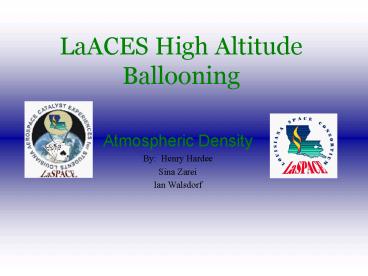LaACES High Altitude Ballooning - PowerPoint PPT Presentation
1 / 21
Title:
LaACES High Altitude Ballooning
Description:
To better understand the effects that freezing temperatures and ... BASE -25 C SPAN -110 C. Part # 442-1026-ND. PRESSURE SENSOR. Data Acquisition. Connections ... – PowerPoint PPT presentation
Number of Views:47
Avg rating:3.0/5.0
Title: LaACES High Altitude Ballooning
1
LaACES High Altitude Ballooning
- Atmospheric Density
- By Henry Hardee
- Sina Zarei
- Ian Walsdorf
2
PROJECT GOALS
- To determine the density of the atmosphere
throughout the flight using the P and T that we
find assuming air is an ideal gas. - To better understand the effects that freezing
temperatures and low pressures can have on
equipment through the atmosphere. - To learn about circuits and electronics and
attempt a hands on experiment.
3
Why pressure changes at different altitudes
- Atmospheric pressure reduces with altitude
- -Due to gravity
- -The gravitational attraction between the earth
and air molecules is greater for those molecules
nearer to earth than those further away - -Molecules further away from the earth have
less weight but they are also 'standing' on the
molecules below them, causing compression
http//www.npl.co.uk/pressure/faqs/atmosaltitude.h
tml
4
Density
Simple density formula
? (rho) - is the density of the substance,
measured in kg m3 m - is the mass of the
substance, measured in kg V - is the volume of
the substance, measured in m3
Boyles Law
R - is the universal gas constant - we used
0.000082057 m3/atmK m - is the molar mass (in
our we use air) kg P pressure atm T
temperature K ? density kg/m3
5
TEMPERATURE SENSOR
- We are using the DS1621ND temperature sensor.
6
PRESSURE SENSOR
- We are using the same pressure sensor that was
used on the HASP project last summer. We did this
for a few reasons the main one being that we are
familiar with the part already. - BASE -25C SPAN -110C
- Part 442-1026-ND
7
Data Acquisition
8
Connections
9
Altitude vs. Pressure
10
Standard Values for Pressure and Temperature
11
Our Expected Data
12
(No Transcript)
13
PAYLOAD CONSTRUCTION
14
Mechanical Design
- We choose to do a double box design instead of
using the pink insulation foam we used thin foam
board because rigidity and thermal
characteristics. - We used pink insulation and fiberglass insulation
between the two boxes to further prevent heat
escaping. - We mounted our temperature sensor outside our
inner box and exposed it to the atmosphere to get
accurate readings. - This design has so far been successful.
15
AUTOCAD DRAWINGS
INNER BOX
16
AUTOCAD DRAWINGS
BIG BOX
17
Mechanical Design
- Weight Budget of the Pay Load
Weight limit
500 g
- Balloon Sat W/ Sensors Wires
82.40 g
- One 9 v Battery
46.6.0 g
- Outer Box
126.5g
- Inner Box
74.4g
500 g - 329.9 g 170.1g
18
Pressure Test
- Upon calibrating our pressure sensor we found to
be a bias error of 2.05 psi. This is due to the
fact that due to time constraints we were not
able to reference our sensor to a 4 volt source
so instead we referenced it to a 5 volt source. - We put our payload in a pressure chamber and it
showed a linear output.
19
Temperature Test
- We tested our payload by putting the box in an
ice chest with dry ice for an hour. - All of our components were fine when we pulled it
out and our data sheet was correct
20
Impact Test
- The payload was dropped from a height of 10 feet
to simulate the force felt upon landing this is
because the nominal descent rate is approx. 20
feet/sec. - We did this test 3 times and nothing was damaged
in the process
21
Acknowledgements
- CSBF
- Dr. Guo
- Dr. Guzik
- Dr. Wefel
- Mr. Giammanco
- Mr. Ellison
- Jeff Kornuta
- NASA































